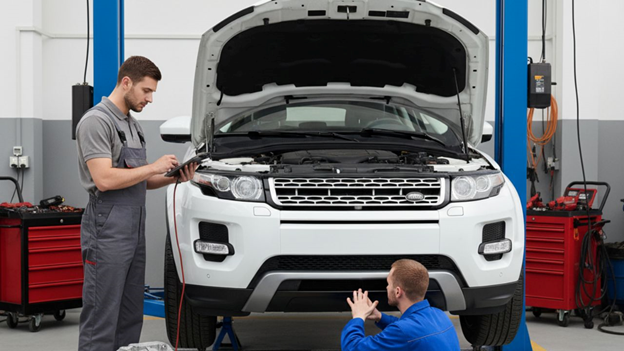5 Signs Your Range Rover Needs a Brake System Overhaul
The braking system represents the most critical safety component in any vehicle, and for Range Rover owners in Dubai and throughout the UAE, maintaining optimal brake performance becomes even more crucial given the high-speed highway driving, heavy stop-and-go traffic, and the substantial vehicle weight that characterizes these luxury SUVs. Range Rover brake systems incorporate sophisticated technologies including large ventilated disc rotors, multi-piston calipers, advanced brake pad compounds, electronic brake force distribution, and emergency brake assist features that deliver exceptional stopping power and control.

However, these complex systems face significant stress from Dubai’s demanding driving conditions, where aggressive driving styles, extreme temperatures, and the weight of fully loaded luxury SUVs place extraordinary demands on brake components. While routine brake maintenance involving pad and rotor replacement keeps systems functional for extended periods, certain conditions indicate that comprehensive brake system overhaul becomes necessary to restore optimal performance, ensure safety, and prevent catastrophic failures. Understanding these warning signs enables Range Rover owners to recognize when professional intervention through qualified Range Rover servicing Dubai facilities becomes essential rather than optional.
1. Persistent Brake Pedal Issues and Abnormal Feel
The brake pedal serves as the primary interface between driver and braking system, providing critical feedback about system condition and performance. Changes in pedal feel, travel distance, or resistance often indicate developing problems that may require comprehensive brake system attention rather than simple component replacement. Range Rover owners should pay particular attention to these pedal characteristics as they provide early warning of potentially serious issues.
Spongy or soft brake pedal feel, where the pedal lacks firmness and feels compressible like a sponge rather than providing solid resistance, typically indicates air contamination in the hydraulic brake fluid or internal brake system leaks allowing pressure loss. Air bubbles in brake fluid compress under pressure, creating the spongy sensation and reducing braking effectiveness. This condition can develop gradually through minor seal leaks or inadequate brake fluid maintenance, or suddenly through catastrophic seal failures. In either case, spongy pedal feel compromises braking performance and requires immediate professional diagnosis.
Excessive brake pedal travel, where the pedal must be depressed significantly farther than normal before brakes engage, suggests several potential problems including worn brake pads approaching their service limits, brake fluid level reduction from leaks or pad wear, or automatic brake adjuster malfunction in vehicles with rear drum parking brake systems. While minor travel increases occur naturally as pads wear, dramatic changes or pedal travel approaching the floor indicate urgent attention requirements.
Brake pedal pulsation during normal braking, distinct from the intentional pulsation produced by anti-lock braking system operation during emergency stops, indicates warped brake rotors creating thickness variations that cause periodic brake force fluctuations. Rotor warping occurs from excessive heat exposure, uneven pad deposits, or manufacturing defects, with symptoms ranging from mild pulsation at highway speeds to severe vibration during any braking application. Significant rotor warping typically requires rotor replacement rather than resurfacing, as modern thin rotors often cannot be machined within acceptable thickness specifications.
Hard brake pedal requiring excessive force to achieve normal braking indicates problems with the brake booster system that provides power assistance to reduce pedal effort. The vacuum-operated or hydraulic brake booster multiplies driver pedal force, making normal braking achievable with reasonable effort. Booster failures from internal diaphragm ruptures, vacuum system leaks, or hydraulic system problems cause dramatically increased pedal effort that may prevent adequate braking in emergency situations. This condition demands immediate attention as it severely compromises safety.
Brake pedal sinking slowly toward the floor when held under steady pressure, even when the vehicle is stationary, indicates internal hydraulic system leaks within the master cylinder, calipers, or brake lines. This condition creates dangerous situations where initial braking may seem adequate but continued pedal application causes progressive pressure loss and reduced braking effectiveness. Internal master cylinder seal failures represent common causes of this symptom, particularly on older Range Rovers or vehicles with neglected brake fluid maintenance.
Professional diagnosis of pedal feel issues requires comprehensive brake system inspection including hydraulic pressure testing, brake fluid contamination assessment, booster function verification, and component-by-component evaluation to identify all problems requiring correction. Comprehensive brake system overhaul addressing pedal issues typically involves master cylinder replacement, brake booster service or replacement, complete brake fluid flush, and replacement of any leaking components. Costs for comprehensive overhaul addressing pedal issues typically range from AED 2,500 to 5,000 depending on specific components requiring replacement and vehicle model complexity.
2. Unusual Noises During Braking Operations
Brake systems should operate relatively quietly during normal use, with only minimal noise from pad-rotor contact during light braking applications. Unusual noises including grinding, squealing, clicking, or groaning during braking indicate various problems that may require comprehensive system attention rather than simple pad replacement. Understanding the meaning of different brake noises helps owners recognize when immediate professional intervention becomes necessary.
Grinding noises during braking represent the most serious acoustic warning, indicating that brake pads have worn completely through their friction material and metal backing plates are contacting rotors directly. This metal-on-metal contact causes rapid rotor damage, dramatically reduced braking effectiveness, and potential brake failure if allowed to continue. Grinding brakes require immediate attention, with repairs typically involving rotor replacement in addition to pads due to rotor damage from the metal contact. The extended nature of grinding damage often necessitates comprehensive brake overhaul rather than simple pad replacement.
High-pitched squealing during braking can indicate several conditions ranging from normal operation to serious problems. Some brake pad compounds naturally produce squealing during certain temperature or pressure conditions, particularly when cold or during light braking applications. However, persistent squealing often indicates worn pads approaching replacement requirements, as many pads incorporate wear indicators designed to produce squealing when friction material reaches minimum thickness. Squealing can also indicate glazed pads or rotors, contaminated friction surfaces, or inadequate pad-caliper lubrication.
Clicking or popping noises during brake application and release suggest loose brake components, worn caliper slide pins, or damaged anti-rattle clips that secure pads within calipers. These symptoms indicate that comprehensive brake service including caliper overhaul, slide pin lubrication, and hardware replacement becomes necessary to restore proper function. Neglecting these sounds can lead to uneven pad wear, reduced braking effectiveness, and potential caliper seizure requiring expensive replacement.
Groaning or moaning sounds during braking, particularly when combined with brake judder or vibration, often indicate pad material problems including incorrect compound selection, contaminated friction surfaces, or pad material transfer creating uneven deposits on rotors. These conditions may require not only pad replacement but also rotor resurfacing or replacement and careful attention to proper pad break-in procedures during installation. Professional facilities experienced with Range Rover brake systems understand the proper pad compounds and installation procedures required for optimal performance.
Hissing sounds when depressing brake pedal can indicate brake booster problems including vacuum leaks or internal diaphragm damage. This symptom requires immediate attention as booster failures compromise braking effectiveness and safety. The sound typically originates from the brake booster area behind the brake pedal and may be accompanied by hard pedal feel or reduced braking power.
Professional diagnosis of brake noise issues requires careful inspection of all brake components including pad thickness and condition assessment, rotor surface evaluation, caliper function verification, hardware condition inspection, and identification of any contamination or damage. Comprehensive brake system overhaul addressing noise issues typically costs AED 2,000 to 4,500 depending on extent of required repairs and whether all four corners require service. Working with experienced car garage dubai facilities ensures proper diagnosis and use of quality range rover spare parts dubai components.
3. Brake Warning Lights and Electronic System Alerts
Modern Range Rover vehicles incorporate sophisticated electronic brake monitoring systems that continuously assess brake function and alert drivers to detected problems through dashboard warning lights and messages. These electronic warnings should never be ignored, as they often indicate serious conditions requiring immediate attention to maintain safe braking performance and prevent system failures.
The brake warning light, typically illuminated in red and featuring the word “BRAKE” or a brake system symbol, indicates several potential conditions including low brake fluid level, parking brake engagement, hydraulic pressure loss, or critical brake system malfunctions detected by monitoring systems. When this light illuminates while driving with parking brake released, immediate inspection becomes necessary. Low brake fluid levels can indicate worn brake pads approaching replacement requirements, hydraulic system leaks, or other conditions requiring correction. Continuing to drive with the brake warning light illuminated risks complete brake failure and should be avoided.
The ABS warning light indicates problems with the anti-lock braking system that prevents wheel lockup during emergency braking. When ABS malfunctions, conventional braking typically remains functional, but the safety benefits of anti-lock control become unavailable. ABS problems can stem from wheel speed sensor failures, hydraulic control unit malfunctions, wiring issues, or control module problems. These electronic systems require specialized diagnostic equipment for proper diagnosis and repair, making professional service through qualified facilities essential.
Electronic Brake Distribution (EBD) warnings indicate problems with systems that optimize brake force distribution between front and rear axles based on loading conditions and vehicle dynamics. EBD failures can compromise braking effectiveness and stability, particularly during heavy braking or when vehicle loading varies significantly from normal conditions. These systems integrate closely with ABS functionality and require comprehensive diagnostic procedures for proper repair.
Brake pad wear sensors, incorporated on many Range Rover models, trigger warnings when brake pad thickness reaches minimum acceptable levels. These sensors utilize electrical contacts that complete circuits when pads wear to specific thicknesses, alerting drivers that pad replacement becomes necessary soon. While not indicating immediate danger, these warnings should prompt scheduling brake service within reasonable timeframes before pad wear reaches dangerous levels.
Electronic parking brake warnings can indicate various problems including parking brake motor failures, cable issues, or control system malfunctions. Electronic parking brake systems, increasingly common on modern Range Rovers, replace traditional mechanical parking brake levers with button-controlled electric motors. These systems prove convenient during normal operation but can experience failures requiring specialized diagnostic equipment and repair procedures only available at qualified service facilities.
Multiple simultaneous brake warnings often indicate serious problems affecting multiple systems, potentially including master cylinder failures, severe brake fluid contamination, or hydraulic control unit malfunctions. When multiple brake warnings illuminate, immediate professional diagnosis becomes essential, as these conditions can indicate impending brake system failure requiring comprehensive overhaul.
Professional diagnosis of electronic brake warnings requires sophisticated diagnostic equipment capable of communicating with brake system control modules, reading detailed fault codes, monitoring sensor data, and performing system function tests. Comprehensive brake system overhaul addressing electronic system problems typically ranges from AED 1,500 to 4,000 depending on specific failures detected and repair complexity.
4. Brake Fluid Contamination and Deterioration
Brake fluid represents the critical hydraulic medium transmitting pedal force to brake calipers throughout the braking system, but this often-overlooked component requires regular maintenance and replacement to maintain optimal brake performance and prevent expensive component damage. Brake fluid contamination and deterioration create conditions requiring comprehensive brake system overhaul rather than simple fluid replacement.
Brake fluid hygroscopicity, its natural tendency to absorb moisture from the atmosphere, causes progressive water contamination that reduces boiling point, creates corrosion throughout hydraulic systems, and compromises braking effectiveness. Fresh DOT 4 brake fluid typically exhibits boiling points exceeding 230°C, but absorbed moisture reduces boiling point progressively, with severely contaminated fluid potentially boiling at temperatures below 150°C. In Dubai’s extreme heat where brake temperatures regularly exceed normal operating ranges, reduced boiling points create dangerous conditions where brake fluid can vaporize under heavy braking, causing complete brake failure through vapor lock.
Dark or discolored brake fluid, appearing brown, black, or cloudy rather than the golden or amber color of fresh fluid, indicates severe contamination and oxidation requiring immediate attention. This contamination typically results from extended service intervals, inadequate system sealing allowing moisture ingress, or internal corrosion releasing particles into the fluid. Contaminated fluid can damage rubber seals, corrode aluminum and steel components, and clog small hydraulic passages throughout the brake system.
Internal brake system corrosion from moisture-contaminated brake fluid causes progressive damage to master cylinders, calipers, ABS control units, and brake lines. Corroded internal surfaces create seal failures, sticky pistons, and potential complete component failures requiring replacement rather than simple service. Comprehensive brake fluid replacement intervals, typically recommended every two years or 40,000 kilometers, prove essential for preventing this expensive damage. Range Rover owners in Dubai should consider even more frequent brake fluid service given the extreme operating conditions and their effects on fluid degradation.
Professional brake fluid testing using specialized equipment can measure actual fluid boiling point, moisture content percentage, and contamination levels, providing objective data about fluid condition. These tests cost nominal amounts but provide valuable information about whether simple fluid replacement proves adequate or whether more comprehensive brake system overhaul becomes necessary due to contamination damage.
Brake fluid flush procedures must follow proper protocols including complete system draining, flushing with fresh fluid to remove contaminated residue, and bleeding procedures at each wheel to eliminate air and ensure fresh fluid throughout the system. Comprehensive brake fluid service typically costs AED 300 to 600 depending on system capacity and complexity, representing cost-effective preventive maintenance compared to component damage from neglected fluid maintenance.
When brake fluid contamination has caused internal component damage, comprehensive brake system overhaul becomes necessary, involving master cylinder replacement, caliper rebuilding or replacement, ABS hydraulic unit service, and potentially brake line replacement if corrosion proves severe. These comprehensive overhauls typically cost AED 3,000 to 6,000 but restore brake system integrity and reliability.
5. Uneven Brake Wear and Performance Imbalances
Brake systems should wear relatively evenly across all four wheels, with front brakes wearing somewhat faster than rear brakes due to weight transfer during braking. Significant wear imbalances or performance differences between wheels indicate problems requiring comprehensive diagnostic evaluation and potentially complete brake system overhaul rather than simple pad replacement on affected wheels.
Severely uneven brake pad wear between left and right sides of the vehicle indicates caliper problems on the side with excessive wear, suggesting sticky or seized caliper pistons preventing proper pad retraction. Calipers should allow pads to back away slightly from rotors when brakes release, but corrosion, contamination, or seal failures can cause pistons to stick in applied positions, creating continuous brake drag that rapidly wears pads and overheats components. Seized calipers require replacement or comprehensive rebuilding rather than simple pad replacement.
Premature pad wear on one axle compared to the other suggests brake force distribution problems potentially involving electronic brake control system malfunctions, proportioning valve issues, or hydraulic problems affecting pressure distribution. These conditions require diagnostic evaluation to identify root causes before implementing repairs, as simply replacing worn pads without addressing underlying problems results in rapid repeat wear.
Excessive rotor wear creating grooves, heat spots, or thickness variations indicates problems beyond normal wear patterns, suggesting pad compound incompatibility, caliper problems creating uneven pressure distribution, or contamination affecting brake performance. Rotors exhibiting severe wear require replacement, but identifying and correcting root causes prevents rapid degradation of replacement components.
Brake pulling, where the vehicle pulls to one side during braking application, indicates significant performance imbalance between left and right brakes. Common causes include seized calipers on the non-pulling side, contaminated pads reducing friction on the pulling side, hydraulic problems affecting brake force, or worn suspension components affecting brake force transfer. Brake pulling creates dangerous handling characteristics demanding immediate professional diagnosis and comprehensive repair.
Professional diagnosis of brake imbalances requires comprehensive inspection of all brake components at all four corners, including pad thickness measurements, rotor thickness and condition assessment, caliper function verification, hydraulic pressure testing, and electronic system evaluation. Comprehensive brake system overhaul addressing performance imbalances typically costs AED 2,500 to 5,000 depending on extent of repairs required.
Understanding these five critical warning signs enables Range Rover owners throughout Dubai and the UAE to recognize when comprehensive brake system overhaul becomes necessary for maintaining optimal safety and performance. The sophisticated brake systems protecting occupants and valuable Range Rover vehicles demand proper maintenance through qualified Range Rover servicing dubai facilities using appropriate range rover spare parts dubai components, but with proper attention and timely intervention, these systems deliver the exceptional stopping power and control that Range Rover owners expect and deserve. When any of these warning signs appear, prompt professional diagnosis through experienced car garage dubai facilities provides the safest path forward.






